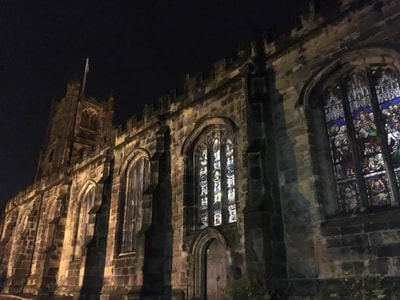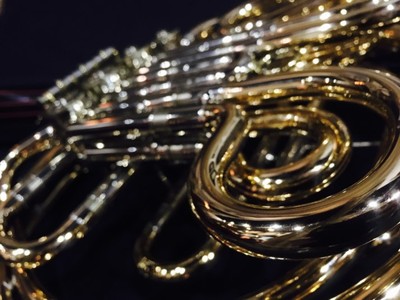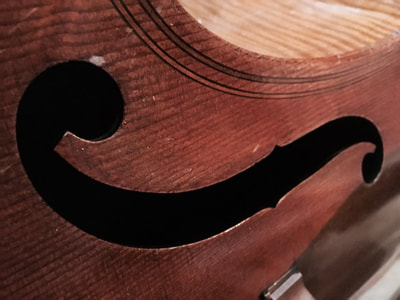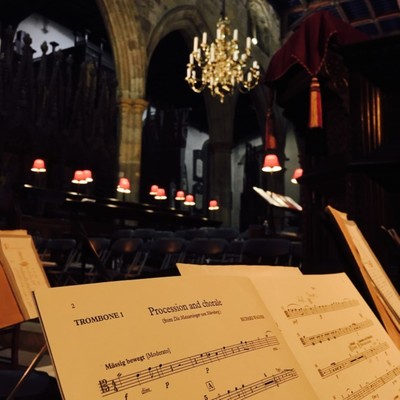2017 Winter Concert - Opera Highlights & Carols
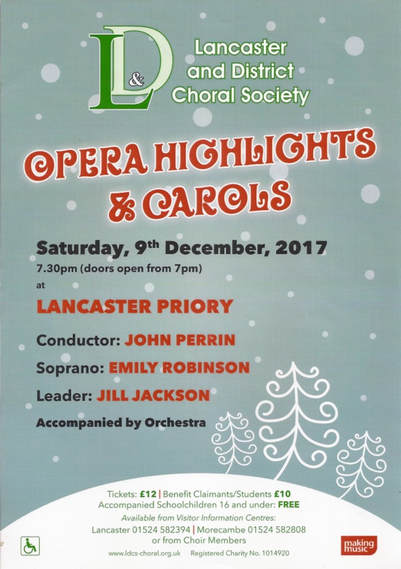
Date: 9th December 2017
Location: Lancaster Priory
The Choral Society performed operatic highlights from the notable composers of Baroque and Romantic periods. They sang popular extracts by Purcell, Bizet, Borodin, Mascagni, Verdi, Wagner and Puccini.
The second part featured eight carols, some of which were accompanied by orchestra. The composers included Bach, Willcocks, Rutter and Bullard, together with the popular spiritual Mary had a Baby arranged by Malcolm Sargent.
Location: Lancaster Priory
The Choral Society performed operatic highlights from the notable composers of Baroque and Romantic periods. They sang popular extracts by Purcell, Bizet, Borodin, Mascagni, Verdi, Wagner and Puccini.
The second part featured eight carols, some of which were accompanied by orchestra. The composers included Bach, Willcocks, Rutter and Bullard, together with the popular spiritual Mary had a Baby arranged by Malcolm Sargent.

Soprano - Emily Robinson
Emily has long been an active member of the musical community and a familiar voice to festival choruses and choirs in the South Lakes area. With a repertoire spanning the musical spectrum from Baroque to Britten, Monteverdi to Modern, she sings Bernstein and Gilbert & Sullivan or Mozart and Handel with equal gusto.
Emily has long been an active member of the musical community and a familiar voice to festival choruses and choirs in the South Lakes area. With a repertoire spanning the musical spectrum from Baroque to Britten, Monteverdi to Modern, she sings Bernstein and Gilbert & Sullivan or Mozart and Handel with equal gusto.
Musical Programme - Opera Highlights
|
Review of Lancaster and District Choral Society’s Winter Concert
Conductor, singers and players are to be congratulated on a performance of real quality.
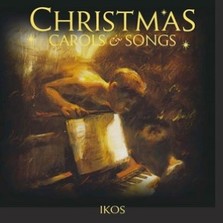
Lancaster and District Choral Society’s Winter Concert promised, in conductor John Perrin’s words, ‘a galaxy of well-known opera’, as well as an opportunity to hear and join in a selection of Christmas Carols. A large audience thoroughly enjoyed a varied and well-chosen programme.
The choir this year is well balanced across the four vocal parts and responded to John Perrin’s clear direction with a magnificent range of tone and volume. Strong singing from Verdi’s Aida and Die Fledermaus by Johann Strauss contrasted effectively with well-controlled quiet passages in Purcell’s Dido and Wagner’s Lohengrin. The extensive demands of Borodin’s Polovtsian Dances were especially well met. Lyrical passages for sopranos and contraltos were matched by exuberant outbursts from the tenors and basses. This is a choir whose sound carries over a full orchestral accompaniment with no hint of over-singing. Good voice production and clarity of diction won the day, supported by thorough rehearsal which enabled the singers to look up and sing confidently, with only occasional reference to the musical score.
Soprano soloist Emily Robinson contributed to several of the items, adapting effortlessly to the diverse character of the various musical styles. Dido’s Lament, by Purcell, was sung with admirably sustained tone, a piece from Bizet’s Carmen in coquettish, playful manner, while the Easter Hymn from Mascagni’s Cavalliera Rusticana demonstrated a powerful, yet controlled upper register.
The orchestra, led by Jill Jackson, was in sparkling form, with excellent brass playing in Wagner and Verdi, some neatly-executed woodwind passages in Borodin and effective string tone in Purcell. They rightly had the floor to themselves with overtures by Strauss and Wagner.
Conductor, singers and players are to be congratulated on a performance of real quality.
Tony Ewens
The choir this year is well balanced across the four vocal parts and responded to John Perrin’s clear direction with a magnificent range of tone and volume. Strong singing from Verdi’s Aida and Die Fledermaus by Johann Strauss contrasted effectively with well-controlled quiet passages in Purcell’s Dido and Wagner’s Lohengrin. The extensive demands of Borodin’s Polovtsian Dances were especially well met. Lyrical passages for sopranos and contraltos were matched by exuberant outbursts from the tenors and basses. This is a choir whose sound carries over a full orchestral accompaniment with no hint of over-singing. Good voice production and clarity of diction won the day, supported by thorough rehearsal which enabled the singers to look up and sing confidently, with only occasional reference to the musical score.
Soprano soloist Emily Robinson contributed to several of the items, adapting effortlessly to the diverse character of the various musical styles. Dido’s Lament, by Purcell, was sung with admirably sustained tone, a piece from Bizet’s Carmen in coquettish, playful manner, while the Easter Hymn from Mascagni’s Cavalliera Rusticana demonstrated a powerful, yet controlled upper register.
The orchestra, led by Jill Jackson, was in sparkling form, with excellent brass playing in Wagner and Verdi, some neatly-executed woodwind passages in Borodin and effective string tone in Purcell. They rightly had the floor to themselves with overtures by Strauss and Wagner.
Conductor, singers and players are to be congratulated on a performance of real quality.
Tony Ewens
Tony Ewens has been Director of Music at St Margaret’s Church, Hornby since 1993. After studying organ with W H Harris and Christopher Gower, he became assistant organist at St Peter’s, Petersfield and accompanist to Petersfield Choral Society. Later, after 10 years as organist and choirmaster at Southernhay URC, Exeter, he moved to Hornby, where he has also been accompanist, then conductor, of Hornby Choral Society.
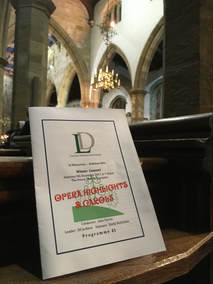
Programme Notes
Procession and Chorale from Die Meistersinger von Nurnberg by Wagner (1813-83)
Premiered in 1868 The Mastersingers of Nuremberg is set in the c16 and centres round a song contest of German guild singers. The opera is a blend of comedy, radiant young love, philosophy and wisdom as embodied in the person of Hans Sachs, the cobbler poet. The procession and chorale plays as the town assembles for the contest and as Sachs appears, the crowd acclaim him and sing one of his songs in praise of dawn. In the event a young travelling knight, Werther, wins the contest and the girl.
Habanera from Carmen by Bizet (1838-75)
Produced in 1875 Carmen is now one of the most popular operas although sadly Bizet did not live to see its success as it was received with initial hostility. Set in Spain this vibrant, colourful and tragic work tells the story of a wild, free-loving, beautiful gypsy, Carmen, and her wooing of an inexperienced corporal, Don Jose. The Habanera heralds Carmen's grand
entrance as she sings to the crowd of the fickle nature of her love, speaks provocatively to Jose and throws him a flower.
Procession and Chorale from Die Meistersinger von Nurnberg by Wagner (1813-83)
Premiered in 1868 The Mastersingers of Nuremberg is set in the c16 and centres round a song contest of German guild singers. The opera is a blend of comedy, radiant young love, philosophy and wisdom as embodied in the person of Hans Sachs, the cobbler poet. The procession and chorale plays as the town assembles for the contest and as Sachs appears, the crowd acclaim him and sing one of his songs in praise of dawn. In the event a young travelling knight, Werther, wins the contest and the girl.
Habanera from Carmen by Bizet (1838-75)
Produced in 1875 Carmen is now one of the most popular operas although sadly Bizet did not live to see its success as it was received with initial hostility. Set in Spain this vibrant, colourful and tragic work tells the story of a wild, free-loving, beautiful gypsy, Carmen, and her wooing of an inexperienced corporal, Don Jose. The Habanera heralds Carmen's grand
entrance as she sings to the crowd of the fickle nature of her love, speaks provocatively to Jose and throws him a flower.
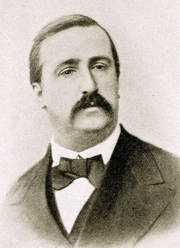 Alexander Porfiryevich Borodin was a Russian Romantic composer, doctor and chemist.
Alexander Porfiryevich Borodin was a Russian Romantic composer, doctor and chemist.
Polovtsian Dances from Prince Igor by Borodin (1833-87)
Borodin's only opera, Prince Igor, occupied him for 17 years and was only completed after his death by Rimsky-Korsakov. The opera relates to an incident in 1185 during the conflict between Russia and the Tartars. Igor, prince of Seversk, is defeated and captured by Khan Konchak of the Polovtsi and the exotic dances are performed by Khan's slave dancers to entertain his honoured prisoner. If the melody sounds familiar, many of Borodin's most famous tunes were used in the 1953 musical Kismet.
Dido's Lament from Dido and Aeneas by Purcell (1659-95)
During his short life the brilliant Purcell had a prolific and varied musical career at the court of William and Mary and in the theatrical life of London. His opera Dido and Aeneas was written around 1689 and is still often performed today. It tells the story of Prince Aeneas who escapes to Italy after the sacking of Troy. En route his ship is driven by storm to Carthage where he meets the widowed Queen Dido. Aeneas is tempted to stay but is tricked into leaving by a sorceress. A heartbroken Dido dismisses Aeneas, sings her lament and dies.
Bridal Chorus from Lohengrin by Wagner (1813-83)
Written in 1850, Wagner's Lohengrin is a legendary tale of knightly chivalry with a magical element. Set in c10 Antwerp it tells the story of EIsa and the mysterious knight who turns out to be Lohengrin, son of Parsifal. In the opera, the Bridal Chorus is a masterpiece of sweet foreboding and a prelude to marital disaster; it is sung as the bridal pair are escorted to the bridal chamber after their wedding. Consequently the words and the context are inappropriate before a wedding, explaining why in church 'Here comes the Bride' is only ever played on the organ!
Borodin's only opera, Prince Igor, occupied him for 17 years and was only completed after his death by Rimsky-Korsakov. The opera relates to an incident in 1185 during the conflict between Russia and the Tartars. Igor, prince of Seversk, is defeated and captured by Khan Konchak of the Polovtsi and the exotic dances are performed by Khan's slave dancers to entertain his honoured prisoner. If the melody sounds familiar, many of Borodin's most famous tunes were used in the 1953 musical Kismet.
Dido's Lament from Dido and Aeneas by Purcell (1659-95)
During his short life the brilliant Purcell had a prolific and varied musical career at the court of William and Mary and in the theatrical life of London. His opera Dido and Aeneas was written around 1689 and is still often performed today. It tells the story of Prince Aeneas who escapes to Italy after the sacking of Troy. En route his ship is driven by storm to Carthage where he meets the widowed Queen Dido. Aeneas is tempted to stay but is tricked into leaving by a sorceress. A heartbroken Dido dismisses Aeneas, sings her lament and dies.
Bridal Chorus from Lohengrin by Wagner (1813-83)
Written in 1850, Wagner's Lohengrin is a legendary tale of knightly chivalry with a magical element. Set in c10 Antwerp it tells the story of EIsa and the mysterious knight who turns out to be Lohengrin, son of Parsifal. In the opera, the Bridal Chorus is a masterpiece of sweet foreboding and a prelude to marital disaster; it is sung as the bridal pair are escorted to the bridal chamber after their wedding. Consequently the words and the context are inappropriate before a wedding, explaining why in church 'Here comes the Bride' is only ever played on the organ!
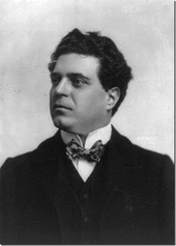 Pietro Antonio Stefano Mascagni
Pietro Antonio Stefano Mascagni
Easter Hymn from Cavalleria rusticana by Mascagni (1863-1945)
Produced in 1890 Cavalleria Rusticana (Rustic Chivalry) was Mascagni's first and only real success. A one-act 'verismo' melodrama, it is a concise passionate tale of love, betrayal and death amongst Sicilian peasants on Easter Sunday. The Gounod-esque Easter Hymn provides local colour andshows a different devotional side to the hot-blooded Sicilian character. However it is merely 'the calm before the storm' as tensions quickly mount and the opera moves towards its inevitable tragic conclusion.
Musetta's Waltz from La Boheme by Puccini (1858-1924)
Written in 1896, La Boheme is a romantic drama of love and death in a Parisian garret. It tells the story of a group of poor bohemian friends, in particular Rodolpho, a poet, and Marcello, a painter and their respective loves Mimi and Musetta. Marcello and Musetta have split up and the bohemian friends are in a Montmartre cafe on Christmas Eve when Musetta arrives on the arm of a rich admirer. She dances and sings of the amorous attentions her looks inspire, in an attempt to win back Marcello who eventually capitulates. The bohemians then all flee leaving Musetta' s sugar daddy to foot the bill!
Produced in 1890 Cavalleria Rusticana (Rustic Chivalry) was Mascagni's first and only real success. A one-act 'verismo' melodrama, it is a concise passionate tale of love, betrayal and death amongst Sicilian peasants on Easter Sunday. The Gounod-esque Easter Hymn provides local colour andshows a different devotional side to the hot-blooded Sicilian character. However it is merely 'the calm before the storm' as tensions quickly mount and the opera moves towards its inevitable tragic conclusion.
Musetta's Waltz from La Boheme by Puccini (1858-1924)
Written in 1896, La Boheme is a romantic drama of love and death in a Parisian garret. It tells the story of a group of poor bohemian friends, in particular Rodolpho, a poet, and Marcello, a painter and their respective loves Mimi and Musetta. Marcello and Musetta have split up and the bohemian friends are in a Montmartre cafe on Christmas Eve when Musetta arrives on the arm of a rich admirer. She dances and sings of the amorous attentions her looks inspire, in an attempt to win back Marcello who eventually capitulates. The bohemians then all flee leaving Musetta' s sugar daddy to foot the bill!
Triumphal Scene from Aida by Verdi (1813-1901)
Commissioned by the Khedive of Egypt and premiered in 1871 at the new Cairo Opera House, Aida is one of Verdi's grandest operas, being both aurally and visually stunning. Set in ancient Egypt at the time of the Pharaohs, it uses magnificent set pieces (with dances, marches and songs) as a spectacular backdrop to the tragic love story of Ethiopian slave Aida and Egyptian general Radames. In the triumphal scene the conquering Egyptian army parades before the King following its defeat of the Ethiopians, and the people and priests give thanks to the King and the gods for the victory.
Highlights from Die Fledermaus by Iohann Strauss II (1825-99)
Known as 'The Waltz King'. [ohann Strauss II wrote Viennese dance music, waltzes and polkas, music for ballet and many light operas. Die Zigeunerbaron (The Gypsy Baron) and Die Fledermaus (The Bar) are still popular and performed today. Die Fledermaus, written in six weeks in 1874, is a baffling mistaken identity sex comedy. It is a funny, frothy, sparkling and tuneful work containing a medley of waltzes and polkas. The overture is a potpourri of the opera's best tunes, the Laughing Song is the chambermaid's attempt to deny her identity whilst the Champagne Chorus attributes all bad behaviour to alcohol!
Commissioned by the Khedive of Egypt and premiered in 1871 at the new Cairo Opera House, Aida is one of Verdi's grandest operas, being both aurally and visually stunning. Set in ancient Egypt at the time of the Pharaohs, it uses magnificent set pieces (with dances, marches and songs) as a spectacular backdrop to the tragic love story of Ethiopian slave Aida and Egyptian general Radames. In the triumphal scene the conquering Egyptian army parades before the King following its defeat of the Ethiopians, and the people and priests give thanks to the King and the gods for the victory.
Highlights from Die Fledermaus by Iohann Strauss II (1825-99)
Known as 'The Waltz King'. [ohann Strauss II wrote Viennese dance music, waltzes and polkas, music for ballet and many light operas. Die Zigeunerbaron (The Gypsy Baron) and Die Fledermaus (The Bar) are still popular and performed today. Die Fledermaus, written in six weeks in 1874, is a baffling mistaken identity sex comedy. It is a funny, frothy, sparkling and tuneful work containing a medley of waltzes and polkas. The overture is a potpourri of the opera's best tunes, the Laughing Song is the chambermaid's attempt to deny her identity whilst the Champagne Chorus attributes all bad behaviour to alcohol!


